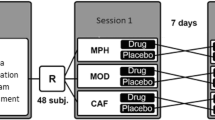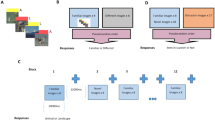Abstract
Cognitive effects of the novel glycine prodrug milacemide (400 mg), the catecholaminergic agonist methylphenidate (20 mg), and placebo were evaluated in 48 healthy young adults. Throughout a 6-h drug treatment day, subjects repeatedly performed tests of target-detection vigilance, immediate and delayed verbal free recall, and Buschke Selective Reminding; total free recall and forced-choice recognition tests were administered at the end of the day. Significant improvement in both vigilance reaction time and Selective Reminding Sum Recall was observed in the methylphenidate group. Contrary to expectations, the milacemide group evidenced significantdeclines in both vigilance perceptual sensitivity and free-recall difference scores (delayed-immediate). Vigilance reaction times significantly decreased over repeat testing in all groups, but only the methylphenidate group differed from placebo. The reaction-time functions for milacemide and placebo were similar, suggesting arousal was not diminished under milacemide and could not account for the cognitive decrements. No significant drug effects obtained for total free recall or recognition performance. Although the glycine prodrug milacemide was ineffective as a cognitive enhancer, the involvement of the NMDA receptor in memory function reported in the literature supports continued exploration of other approaches for manipulating NMDA receptor activity.
Similar content being viewed by others
References
Albers GW (1990) Potential therapeutic uses ofN-methyl-D-aspartate antagonists in cerebral ischemia. Clin Neuropharmacol 13:177–197
Bonhaus DW, Burge BC, McNamara JO (1987) Biochemical evidence that glycine allosterically regulates and NMDA receptor-coupled ion channel. Eur J Pharmacol 142:489–490
Bonhaus DW, Perry WB, McNamamara JO (1990) Decreased density, but not number, ofN-methyl-D-aspartate, glycine and phencyclidine binding sites in hippocampus of senescent rats. Brain Res 532:82–86
Buschke H (1973) Selective reminding for analysis of memory and learning. J Verb Learn Behav 12:543–550
Buschke H, Fuld PA (1974) Evaluation of storage, retention, and retrieval in disordered memory and learning. Neurology 24:1019–1025
Camp JA, Winsberg BG (1984) Clinical utility of animal models of childhood hyperkinesis. Clin Neuropharmacol 7:185–221
Christophe J, Kutzner T, Nguyen-Bui ND, Damien C, Chatelain P, Gillet L (1983) Conversion of orally administered 2-n-pentylaminoacetamide into glycinamide and glycine in the rat brain. Life Sci 33:533–541
Collingridge GL, Bliss TVP (1987) NMDA receptors — their role in long-term potentiation. Trends Neurosci 10:288–293
Collingridge GL, Singer W (1990) Excitatory amino acid receptors and synaptic plasticity. Trends Pharmacol Sci 11:290–296
Cutler NR, Fakouhi TD, Smith WT, Hendrie HC, Matsuo F, Sramek JJ, Herting RL (1993) Evaluation of multiple doses of milacemide in the treatment of senile dementia of the Alzheimer's type. J Geriatr Psychiatr Neurol 6:115–119
Deutsch SI, Mastropaolo J, Schwartz BL, Rosse RB, Morihisa JM (1989) A “glutamatergic hypothesis” of schizophrenia. Clin Neuropharmacol 12:1–13
Dixon WJ (ed) (1985) BMDP statistical software manual. 1985 printing. University of California Press, Berkeley
Drew CJ (1980) Introduction to designing and conducting research, 2nd edn. Mosby, St Louis
Dunn LM, Dunn LM (1981) Peabody Individual Achievement Test-revised. American Guidance Service, Circle Pines, Minn.
Dysken MW, Mendels J, LeWitt P, Reisberg B, Pomara N, Wood J, Skare S, Fakouhi JD, Herting RL (1992) Milacemide: a placebo-controlled study in senile dementia of the Alzheimer type. J Am Geriatr Soc 40:503–506
Evans RW, Gualtieri CT, Amara I (1986) Methylphenidate and memory: dissociated effects in hyperactive children. Psychopharmacology 90:211–216
Gottfries CG (1985) Alzheimer's disease and senile dementia: biochemical characteristics and aspects of treatment. Psychopharmacology 86:245–252
Green DM, Swets JA (1966) Signal detection theory and psychophysics. Wiley, New York
Greenamyre JT, Young AB (1989) Excitatory amino acids and Alzheimer's disease. Neurobiol Aging 10:593–602
Halliday R, Callaway E, Naylor H, Gratzinger P, Prael R (1986) The effects of stimulant drugs on information processing in elderly adults. J Gerontol 41:748–757
Handelmann GE, Nevins ME, Mueller LL, Arnolde SM, Cordi AA (1989) Milacemide, a glycine prodrug, enhances performance of learning tasks in normal and amnestic rodents. Pharmacol Biochem Behav 34:823–828
Hungund BL, Perel JM, Hurwic MC, Sverd J, Winsberg BG (1979) Pharmacokinetics of methylphenidate in hyperactive children. Br J Pharmacol 8:571–576
Johnson JW, Ascher P (1987) Glycine potentiates the NMDA response in cultured mouse brain neurons. Nature 325:529–531
Lawlor BA, Davis KL (1992) Does modulation of glutamatergic function represent a viable therapeutic strategy in Alzheimer's disease? Biol Psychiatry 31:337–350
Naylor H, Halliday R, Callaway E (1985) The effect of methylphenidate on information processing. Psychopharmacology 86:90–95
Newman RP, Weingartner H, Smallberg SA, Calne DB (1984) Effortful and automatic memory: effects of dopamine. Neurology 34:805–807
Paivio A, Yuille JC, Madigan SA (1968) Concreteness, imagery, and meaningfulness values for 925 nouns. J Exp Psychol Monogr Suppl 76 [1/part 2]:1–25
Peeke S, Halliday R, Callaway E, Prael R, Reus V (1984) Effects of two doses of methylphenidate on verbal information processing in hyperactive children. J Clin Psychopharmacol 4:82–88
Quartermain D (1983) The role of catecholamines in memory processing. In: Deutsch JA (ed) The physiological basis of memory. Academic Press, New York, pp 387–423
Quartermain D, Judge ME, Leo P (1988) Attenuation of forgetting by pharmacological stimulation of aminergic neurotransmitter systems. Pharmacol Biochem Behav 30:77–81
Quartermain D, Nuygen T, Sheu J, Herting RL (1991) Milacemide enhances memory and alleviates spontaneous forgetting in mice. Pharmacol Biochem Behav 39:31–35
Rapoport JL, Buchsbaum MS, Weingartner H, Zahn TP, Ludlow C, Mikkelsen EJ (1980) Dextroamphetamine. Its cognitive and behavioral effects in normal and hyperactive boys and normal men. Arch Gen Psychiatry 37:933–943
Saletu B, Gruenberger J (1984) Early clinical pharmacological trials with a new anti-epileptic, milacemide, using pharmaco-EEG and psychometry. Meth Find Exp Clin Pharmacol 6:317–330
Saletu B, Gruenberger J, Linzmayer L (1986) Acute and subacute CNS effects of milacemide in elderly people: double-blind, placebo-controlled quantitative EEG and psychometric investigations. Arch Gerontol Geriatr 5:165–181
Schwartz BL, Hashtroudi S, Herting RL, Handerson H, Deutsch SI (1991) Glycine prodrug facilitates memory retrieval in humans. Neurology 41:1341–1343
Squire LR (1987) Memory and brain. Oxford University Press, New York, pp 39–55
Squire LR, Zola-Morgan S (1991) The medial temporal lobe memory system. Science 253:1380–1386
Strauss J, Lewis JL, Klorman R, Peloquin L, Perlmutter RA, Salzman LF (1984) Effects of methylphenidate on young adults' performance and event-related potentials in a vigilance and a paired-associates learning test. Psychophysiology 21:609–621
Strupp BJ, Bunsey M, Levitsky D, Kesler M (1991) Time-dependent effects of post-trial amphetamine treatment in rats: evidence for enhanced storage of representational memory. Behav Neural Biol 56:62–76
Underwood BJ (1983) Attributes of memory. Scott, Foresman, Glenview Ill., pp 210–239
Weingartner H, Rapoport JL, Buchsbaum MS, Bunney WE Jr, Ebert MH, Mikkelsen EJ, Caine ED (1980) Cognitive processes in normal and hyperactive children and their response to amphetamine treatment. J Abnorm Psychol 89:25–37
Winsberg BG, Camp JA (1981) Psychostimulant therapy for behavior disorders: a status review. In: Ochroch R (ed) The diagnosis and treatment of minimal brain dysfunction in children. A clinical approach. Human Sciences Press, New York, pp 136–146
Author information
Authors and Affiliations
Rights and permissions
About this article
Cite this article
Camp-Bruno, J.A., Herting, R.L. Cognitive effects of milacemide and methylphenidate in healthy young adults. Psychopharmacology 115, 46–52 (1994). https://doi.org/10.1007/BF02244750
Received:
Revised:
Issue Date:
DOI: https://doi.org/10.1007/BF02244750




